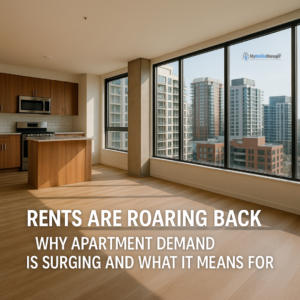After two years of cooling rents and an unprecedented wave of new apartment construction, the U.S. rental housing market is shifting again. According to a recent analysis highlighted by the New York Post, demand for apartments is surging back, signaling that the era of tenant-friendly conditions may be giving way to renewed landlord leverage.
This change comes at a critical time for millions of renters across the country who have enjoyed slightly more favorable conditions in recent years. With vacancies tightening, rent concessions shrinking, and new supply expected to slow in 2025, the outlook for affordability is growing more complex.
The Supply Story: A Building Boom Meets Absorption
Between 2022 and 2024, developers delivered nearly 1.2 million new apartments, the largest three-year construction surge in more than four decades. This rapid influx of new units initially created downward pressure on rents and pushed vacancy rates higher, especially in fast-growing Sunbelt markets.
However, recent data shows the opposite trend: demand has bounced back strongly. Analysts now project that much of this new supply will be absorbed faster than expected, largely because of several converging forces:
-
Higher mortgage rates and record home prices: Homeownership is out of reach for many households, prolonging the time renters stay in apartments.
-
Return-to-office policies: With more employers mandating in-person work, demand for urban and commuter-friendly apartments has rebounded.
-
Strong job growth: As employment stabilizes, more households are forming, creating steady rental demand.
By late 2024, an additional 672,000 units were slated for completion, but many analysts expect new construction to taper off in 2025 as financing costs rise and developers pull back. This slowdown in new projects could leave demand ahead of supply, fueling rental growth into next year.
Regional Realities: Where Renters Will Feel the Pinch First
The national rental market is tightening, but the effects aren’t evenly distributed.
-
Austin, Texas is the poster child for overbuilding. With vacancy rates above 15%, landlords are still offering deep concessions such as multiple months of free rent to attract tenants.
-
Coastal cities like New York, Los Angeles, and San Francisco are seeing stronger rebounds. Limited new supply and robust urban job recovery have allowed landlords in these metros to raise rents at renewal by more than 5% in some cases.
-
Sunbelt metros (Atlanta, Phoenix, Tampa) are still digesting large pipelines of new construction. While rents are stabilizing, many local markets remain oversupplied in the short term.
-
Midwestern markets (Cleveland, Kansas City, Indianapolis) remain relatively affordable, but even here, renewed demand could push rents upward as coastal transplants seek lower-cost alternatives.
This uneven recovery highlights that while national averages matter, local dynamics jobs, construction pipelines, population trends are what ultimately shape renters’ realities.
What Rising Demand Means for Key Players
For Renters
The days of plentiful concessions may be numbered. National data shows that renewal rent hikes averaged 3.5% in 2024, and new lease prices are climbing again. Renters in tight markets should prepare for stiffer competition, fewer deals, and landlords less willing to negotiate.
Still, savvy renters can take advantage of markets like Austin or Atlanta, where oversupply continues to favor tenants at least in the short term. Shopping around for lease incentives may still yield significant savings.
For Landlords and Investors
After weathering two years of softer demand and downward pricing pressure, landlords are regaining confidence. Stabilized occupancy is giving them room to push rents, reduce giveaways, and position properties more aggressively.
Multifamily investors are also showing renewed interest. Transaction volumes in apartment buildings are rebounding, especially in markets with long-term demand drivers such as tech employment or limited land availability.
For Policymakers and Housing Advocates
A tightening rental market inevitably renews concerns about affordability. As rents accelerate, wage growth may not keep pace, particularly for middle- and low-income households. This will increase pressure on city governments to consider:
-
Expanding rental assistance programs
-
Debating or revisiting rent control policies
-
Incentivizing new affordable housing construction
-
Reevaluating zoning restrictions that limit housing density
The policy debate will intensify as affordability challenges spread beyond high-cost coastal metros into secondary markets.
The 2025 Outlook: A New Rental Cycle Ahead
Looking ahead, the next phase of the rental cycle is beginning to take shape:
-
Rent Growth Resurgence – Analysts project rent growth could return to the 5–10% range nationally if demand outpaces slowing supply.
-
Localized Overhangs – Markets with large pipelines, such as Austin or Nashville, may lag behind until excess supply is absorbed.
-
Capital Markets Recovery – Investor activity in multifamily is set to accelerate as lenders and buyers regain confidence in rental fundamentals.
-
Affordability Crunch – With fewer concessions and renewed rent hikes, households already stretched thin will face tough choices, from downsizing to relocating.
Conclusion: A Market in Transition
The U.S. rental market is entering a new chapter. After an unusual period where renters briefly had the upper hand, the balance of power is shifting back to landlords. For tenants, that means higher costs and fewer deals. For landlords and investors, it means renewed pricing power.
The big question is whether policymakers will act to cushion the blow for households most affected by rising rents or whether the affordability crisis will deepen in 2025.
One thing is clear: renters, landlords, and policymakers alike will need to navigate a market that’s roaring back, faster and stronger than many anticipated.
Source: New York Post, “Rents Set to Roar Back as Apartment Demand Surges”

